Mike Nelson, Hayward Gallery, London, UK
A personal reflection on Mike Nelson's exhibition, Extinction Beckons
Mike Nelson, Triple Bluff Canyon, 2004
I have been lucky to visit several Mike Nelson exhibitions over the past two decades, so visiting Mike Nelson: Extinction Beckons, which is currently on display at the Hayward Gallery, London, UK, was like stepping into a familiar dystopian world that I have visited before.
One of the most visually striking installations in the exhibition is Triple Bluff Canyon, 2004. A partially buried woodshed is literally ‘drowned in a desert’. Sand has engulfed the structure and nearly reaches the ceiling of the gallery. The scene is as if a wild sandstorm has ravaged the land, made all the more poignant by the inclusion of the work, M25, 2023, a collection of ragged, blown-out tyres which scatter across the sandy terrain, appearing to have been ripped from cars in the eye of the storm. It is a desolate and devastated place and although you, as the visitor, stand under the illuminated skylights of the upper gallery, you do not feel like you are viewing art in London, you really feel like you are lost in the Middle East, seeking refuge or signs of life in the desolate landscape.

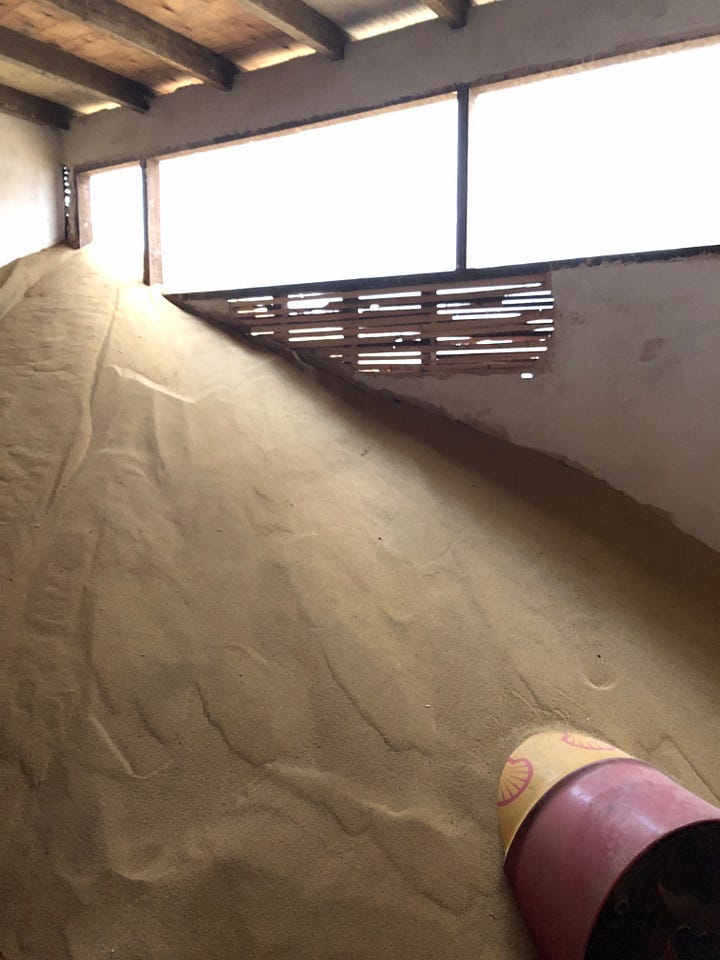
Mike Nelson, Triple Bluff Canyon, 2004, & M25, 2023
To the right of the installation there is a long tunnel, which leads to a perfectly concealed darkroom, hidden beneath the imposing sand dune. The room is quite large, and stepping inside, you would have no idea, other than having just walked from the sandy scene above, that you are buried underneath several truckloads of sand. An eerie red light illuminates the room, in this environment feeling more sinister than perfunctory. The sense of abandonment is just as palpable in this room as in the expanse of ‘desert’ above, as if the photographer has fled in a hurry, leaving all their possessions behind. Photographs hang on lines from the ceiling, on closer inspection, which I recognised as installation photography from Nelson’s exhibition at Modern Art Oxford in 2003, where I worked at the time.
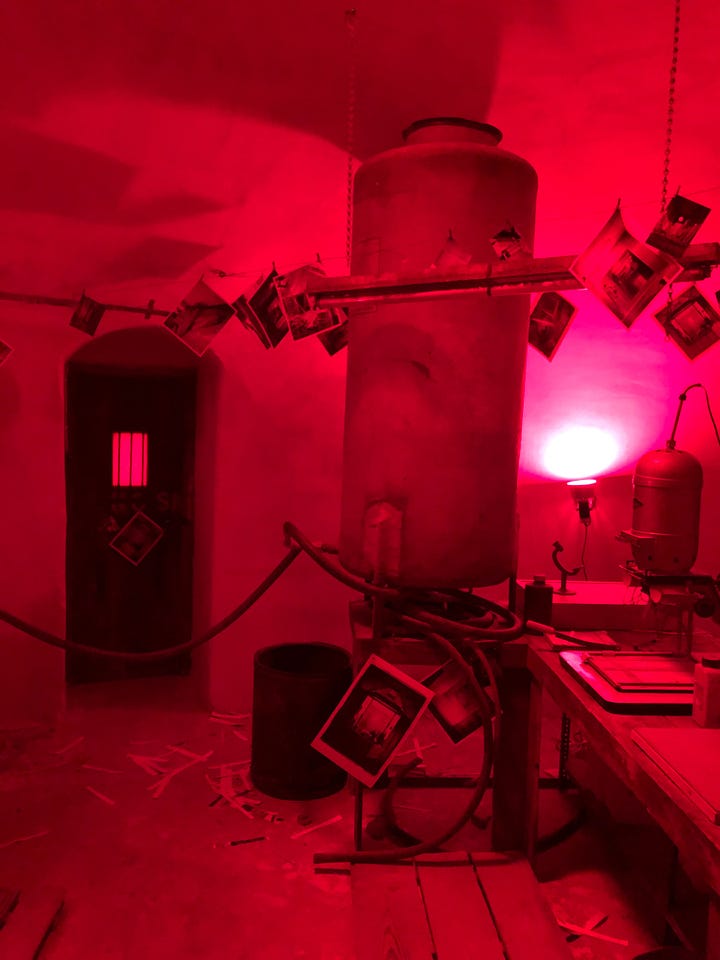
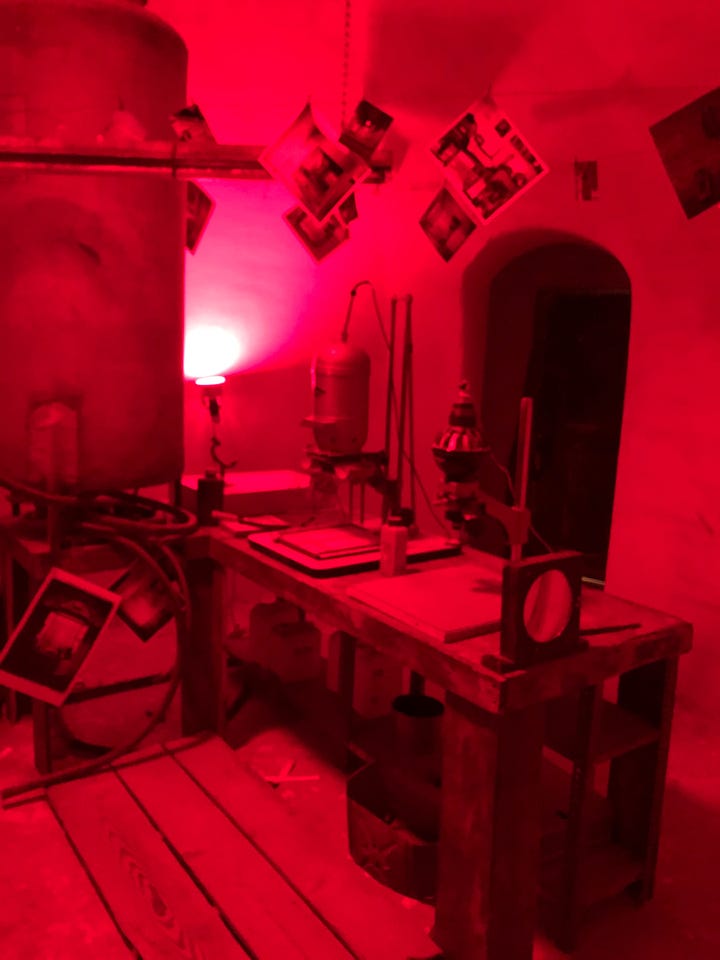
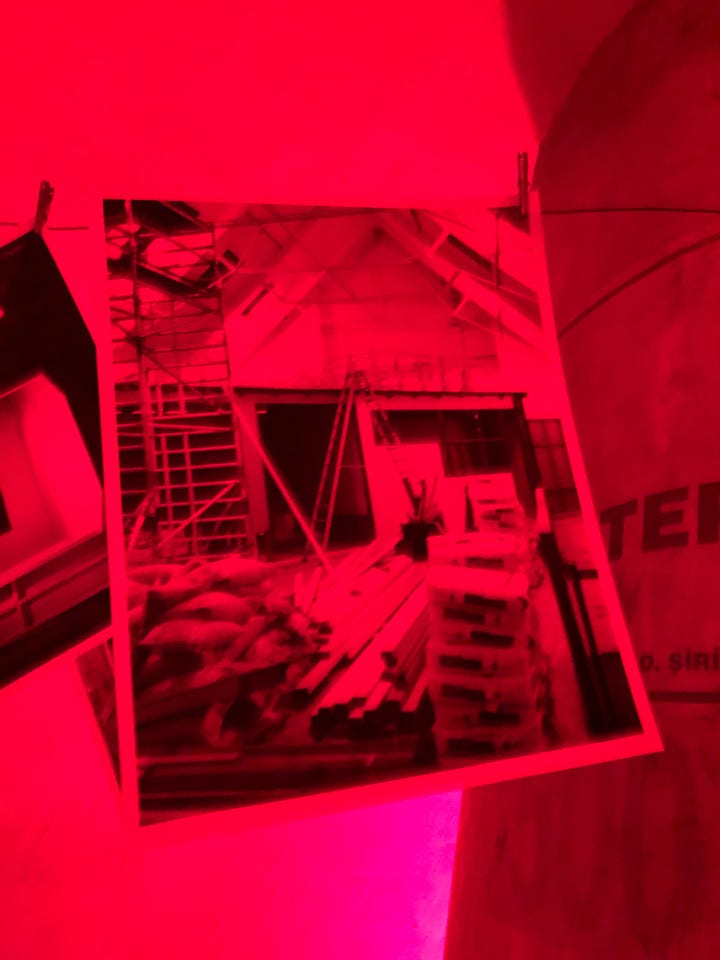

Mike Nelson, I IMPOSTER (the darkroom), 2011
Nelson cleverly revisits his previous works in subsequent installations – reimagining and reinventing. The accompanying wall text for the darkroom installation, I IMPOSTOR (the darkroom), 2011, states that the created environment contributes to a disorientating understanding of time, space, and memory. Standing in the depths of the darkroom you really do feel like time is standing still, like you are witnessing a snapshot of a previous life, a previous time. For me, memory particularly resonated within this space. I thought back to my time at Modern Art Oxford, and couldn’t believe it was nearly twenty years ago that Nelson’s exhibition was installed there. It certainly feels like a previous life to me. The photographer’s life, the artist’s life, my life - a life, within a life, within a life, previous lives and fiction, all wrapped together.
The exhibition title, Extinction Beckons, is certainly reflective of the current human condition and the world. Nelson’s work has always presented a series of deserted scenes and abandoned rooms, invoking the trace of a multitude of previous lives, untold stories, and past encounters, which draws, you, the visitor, into the whispers of a hundred memories.
Triple Bluff Canyon was made during the Iraq war, but with its reconstruction at the Hayward Gallery, it is still as relevant today as it was when it was first conceived. We are still living in a war-ravaged world. It was only recently, that I read in the newspaper that scientists had given their ‘final warning’ over climate change, to act now or it will be too late. This sandy desolate scene could be a vision of the future where temperatures soar and the sun beats down on an uninhabited dusty planet. Extinction really does beckon at every moment.
Mike Nelson, I IMPOSTER, 2011
Nelson’s installations play out like sets from a post-apocalyptic tv drama, but this time you are living it. They fill you with feelings. How have you survived to witness this? Who else is left to witness this with you? You become a conspirator with fellow visitors but everyone shuffles around in stunned silence, not ready to unite in this alien, futuristic, reality. Nowhere is this more apparent then within the labyrinth of rooms created by Nelson for the installation, The Deliverance and The Patience, 2001, originally created for the Venice Biennale. I have walked around Nelson’s mazes of rooms before, in Margate in 2005, at Tate Britain in 2010, and in the British Pavilion at the 2011 Venice Biennale, but this didn’t stop me from hesitating in a brief moment of anxiety when seeing the size of the installation from the outside, filling the downstairs gallery. Having stepped through the first door though, I was fully enthralled by the maze of scenes I encountered, interconnecting rooms all empty of human presence but each loudly illustrating the intimate lives of strangers.
Mike Nelson, The Deliverance and The Patience, 2001
The wall text for The Deliverance and The Patience, explains the visitor’s journey through the rooms as having more in common with ‘the shifts in space and time experienced whilst reading a novel or watching a film, than with the way we usually move through architectural space.’ This certainly feels true, as your imagination becomes hypersensitive as you walk through the labyrinth of alternate realities, although to me it felt like an anthology of short stories, each so wildly different, that you feel like you are jumping from one life story to another.
Some rooms feel utterly deserted, while others have an overwhelming sense of belonging to someone. These are the rooms that intrigued me most. One room that my thoughts have returned to often, since visiting the exhibition, I think of as ‘Ahmed’s workroom’. A workbench sits at the back of a dirty room, a stool in front of it with the seat taped together. A rusty fan sits on the floor, creating a whir of white noise and a shallow breeze. Electric wires coil like snakes across the floor. This unremarkable scene is made instantly personal by the name ‘Ahmed’ carved into the dusty table top, accentuated and ringed by a curved border. I instantly wanted to know about Ahmed’s life. Who is he? Or who was he? His presence felt tangible but also removed. Did he choose to work here or was he forced work here? Is Ahmed his first name or his last name? The wall to the left of the workbench has been ripped apart, like a wild animal has torn through the side of the space. The same can be seen in the corridors of this installation, Nelson’s homage to his previous work, To the memory of H. P Lovecraft, 1999, which was reconstructed as part of the Hayward Gallery’s Psycho Buildings exhibition in 2008, again, where I was working at the time. On my second visit to the room, I began to notice more details, probably missed by most. A mirror on the right-hand wall, with a damaged frame, and an out of place Jamaica sticker in the top left corner, looks quite ordinary, until you look very closely and see the faint imprint of sparkly lip gloss and the presence of a pair of full lips which kissed the mirror in a past life. My mind raced at discovering this. Is this the reason that Ahmed is no longer here? I suddenly could not shift the idea that after a long and torturous day of work, Ahmed took pleasure in dressing up and going out somewhere forbidden. The lips that lingered on the mirror, (a lover’s? Or his own?) were his downfall, and the reason why he is no longer there.
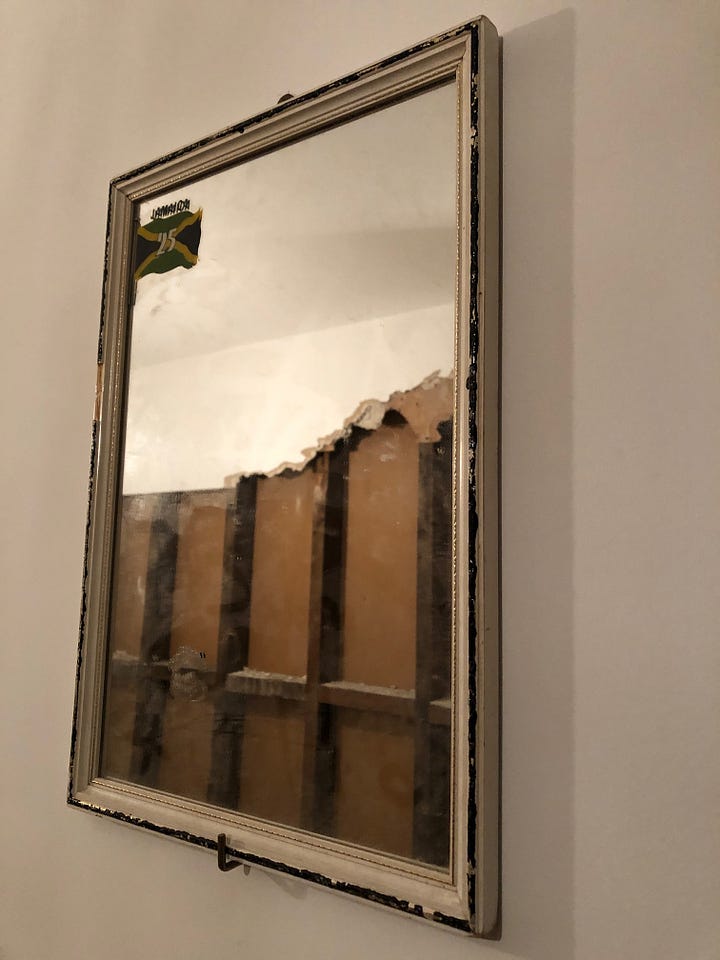
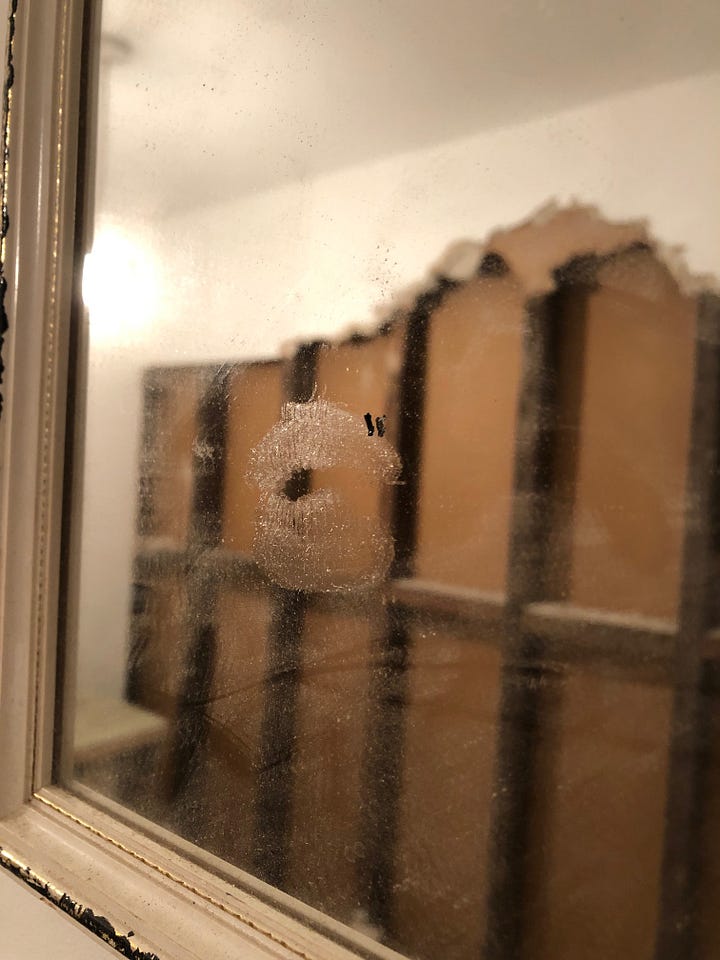
Mike Nelson, The Deliverance and The Patience, 2001, (details)
Another room that screams of personal presence and previous lives is a small room painted in a salient red. A table and two mismatched chairs are positioned in the centre of the space. A colourful poster on the back wall shows a drawing of a women and man, both wearing red tops, aboard a small boat, delivering white parcels, tied with red ribbon. An overhead old-fashioned pool table light shines from beneath the fringed border of the shade and illuminates the table top. On the table is a roulette wheel and a small pile of cards, but instead of playing cards, the top card shows ‘Le Bateleur’ from a tarot deck, ‘The Magician’, a character with all potential, like a starting point from which the universe appeared.
Slung on the back of the nearest chair is a leather jacket, the personal detail that fills the room with human presence and makes you acutely aware of human absence. Where has this man gone? Was he gambling or having a tarot reading? It’s as if the characters from this room have just disappeared.
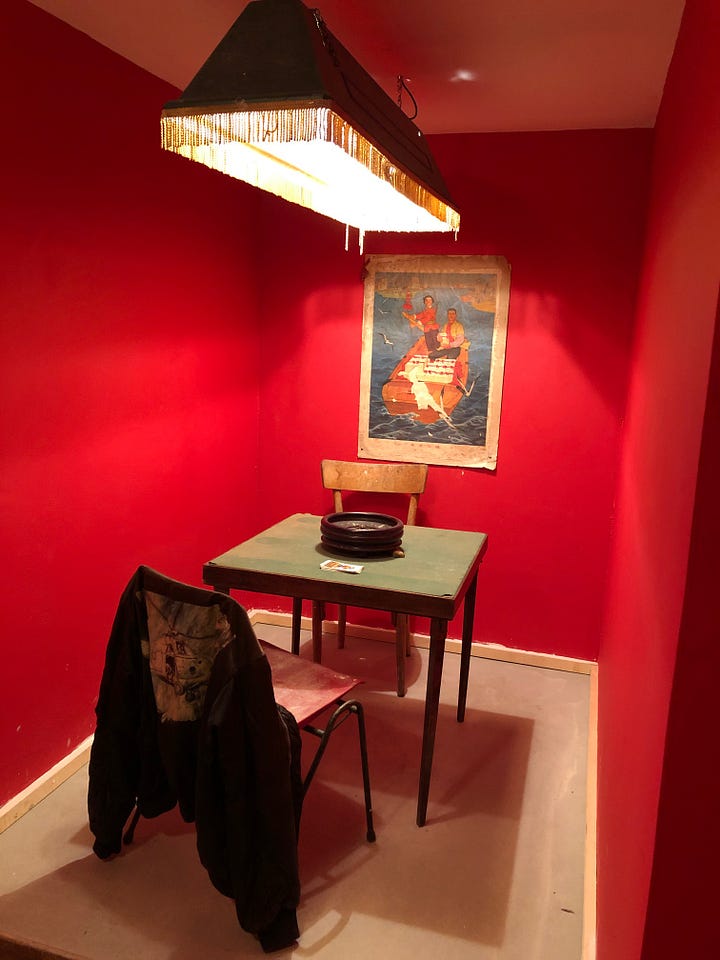
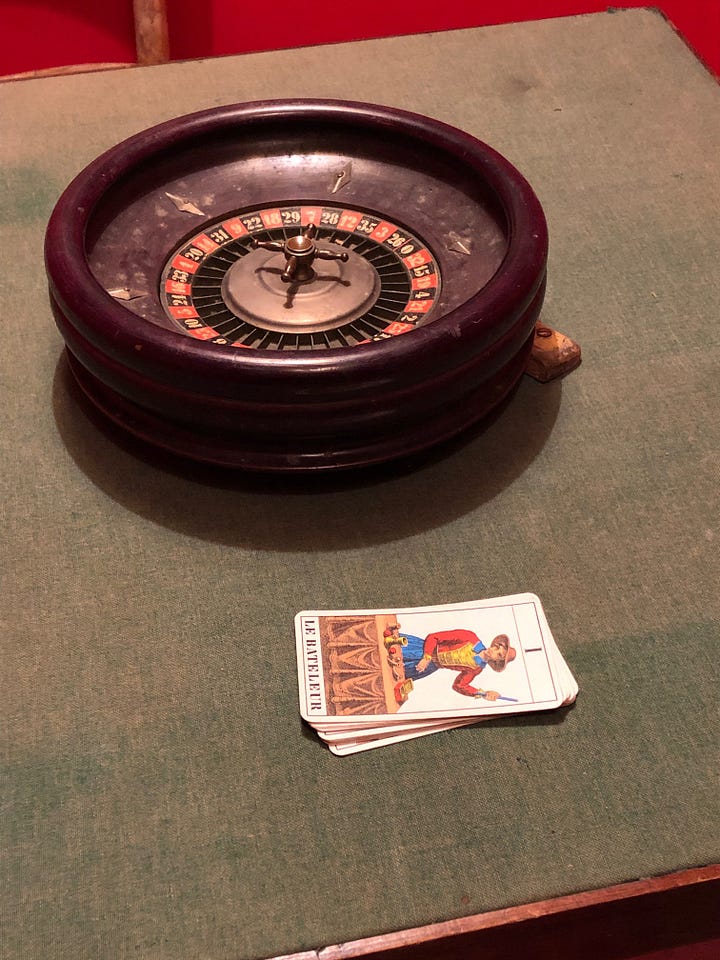
Mike Nelson, The Deliverance and The Patience, 2001, (details)
The Deliverance and The Patience is filled with fascinating scenes, a travel agent, a ship’s captain’s bar, a prayer room, a hotel or strip club reception, a satanic altar, but in all of these spaces I couldn’t help but feel an overwhelmingly male presence. These rooms are haunted by the ghosts of men, each powerful, or powerless. The entire installation exudes the aura of a host of male characters. Nelson’s attention to detail in his installation is astounding and I imagine several repeat visits to his work would be needed to discover the majority of his carefully thought through references and suggestions. I love the recurring motifs in his work, the maze of different doors which lead to the next story, the red-light bulbs, the softly whirring fans, the old-fashioned telephones, the cigarette butts in the ashtray and on the floor of the corridors. Nelson’s work really must be experienced in person as no description can aptly recreate the feelings the works induce in you. For each person the stories will be different.
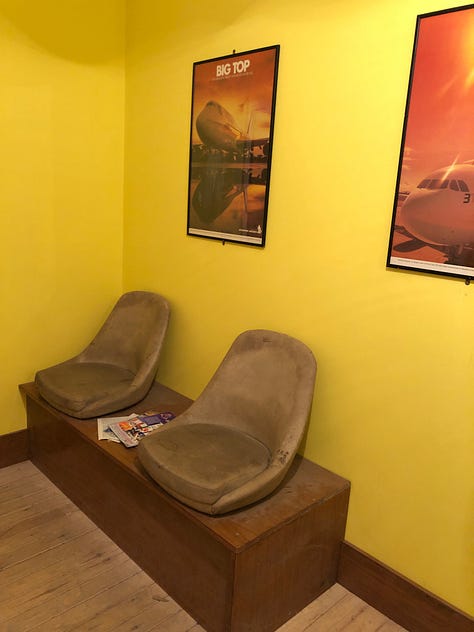
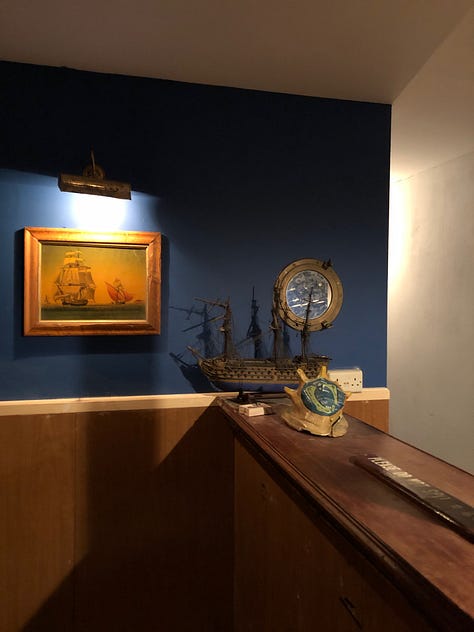
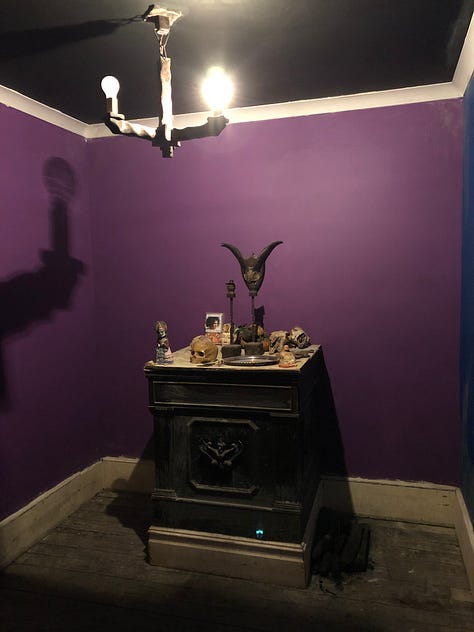
Mike Nelson, The Deliverance and The Patience, 2001, (details)
The exhibition includes several other of Mike Nelson’s most recognisable works, The Asset Strippers, 2019 looking much more comfortable within the brutalist architecture of the Hayward Gallery than their previous display in the marble Duveen Galleries of Tate Britain. Nelson’s Studio Apparatus series, 2014, and his fictional biker gang, The Amnesiacs, 1996-ongoing. Not to forget Triple Bluff Canyon (the projection room), 2004, a full-scale reconstruction of Nelson’s studio from 2003, another work which I remember fondly from his Modern Art Oxford exhibition.
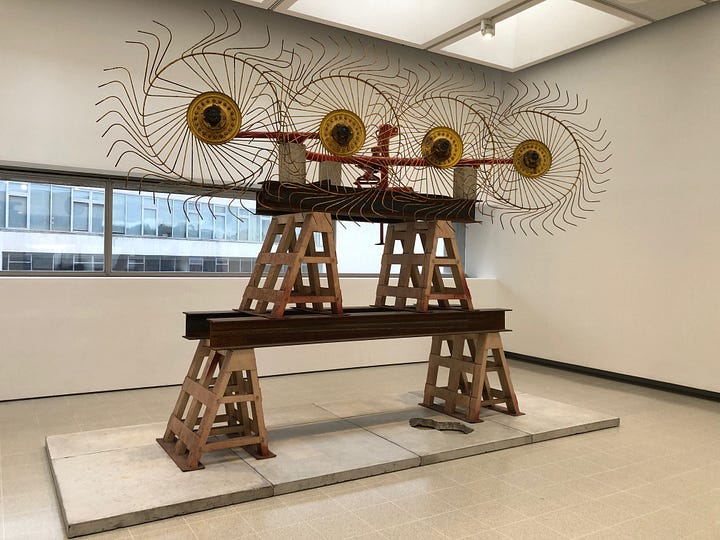
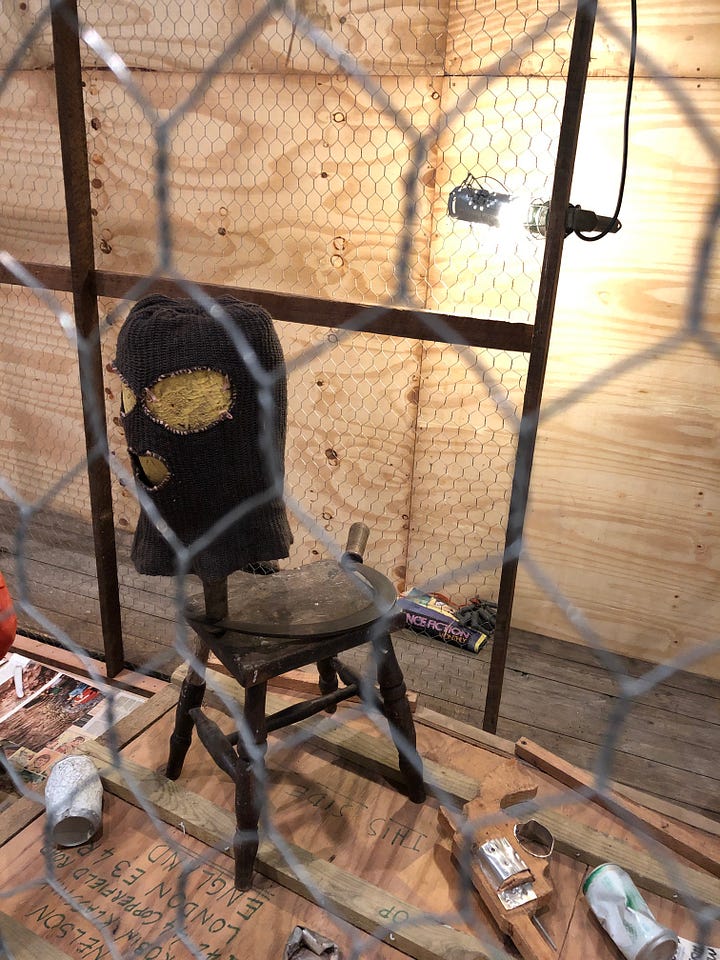
Mike Nelson, The Asset Strippers, 2019, & The Amnesiacs, 1996-ongoing (details)
This major survey of Mike Nelson’s work is a triumph and a wonderful celebration of the artist’s incredible installations and imagination. In every gallery you are drawn into fictional worlds and alternate realities, so strangely deserted, but so familiar and so full of human presence even in their absence. Do go and encounter this dystopian experience, where reality and fiction merge and it becomes truly believable that extinction beckons.
Mike Nelson: Extinction Beckons is on display at Hayward Gallery, London, UK until 7 May 2023.
All photographs are my own.

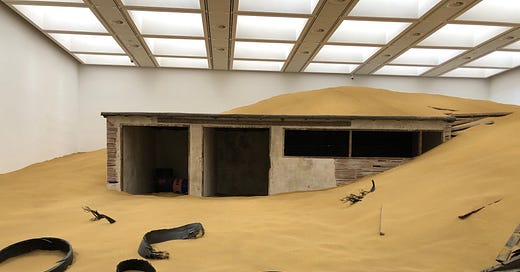



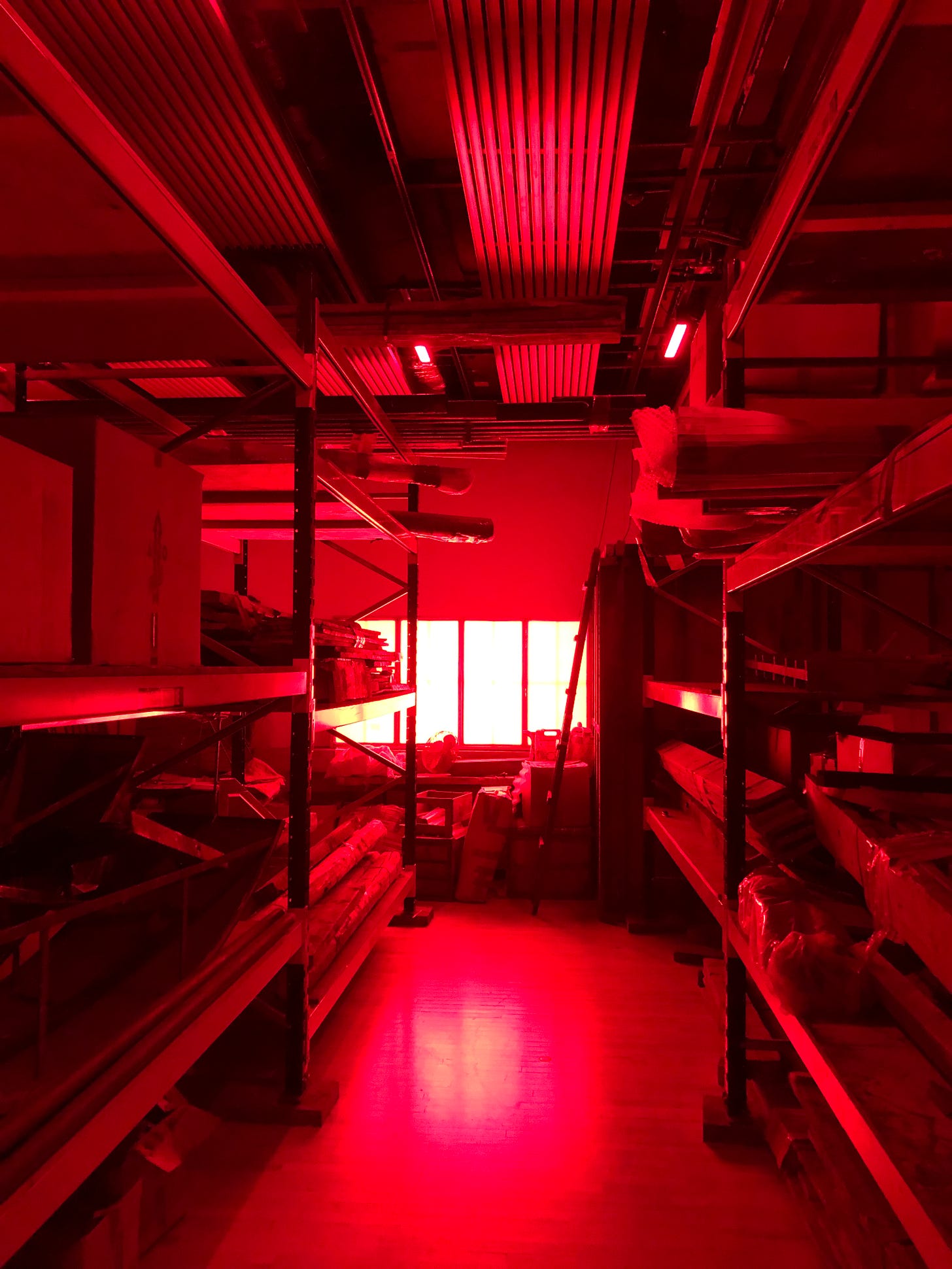
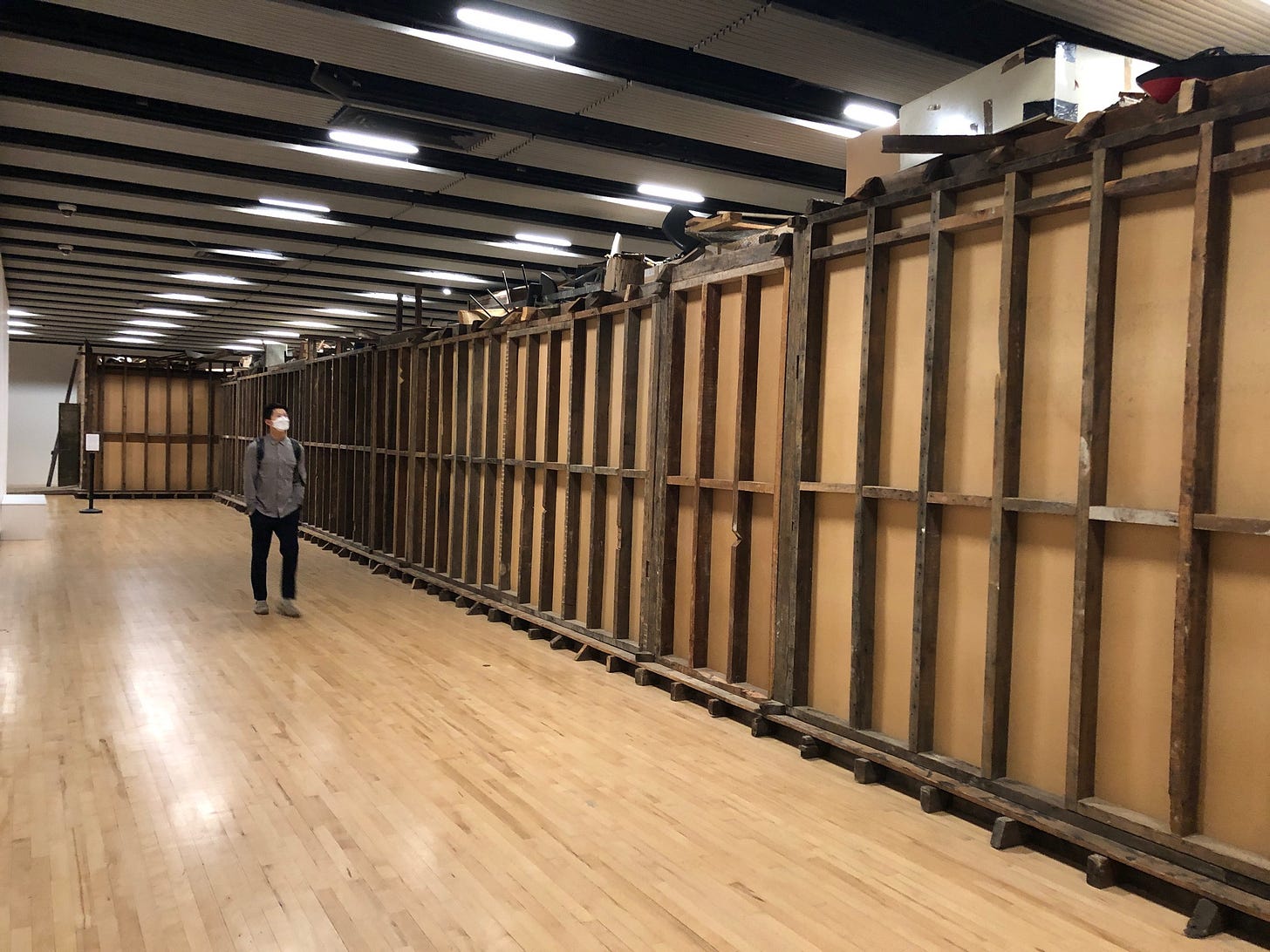
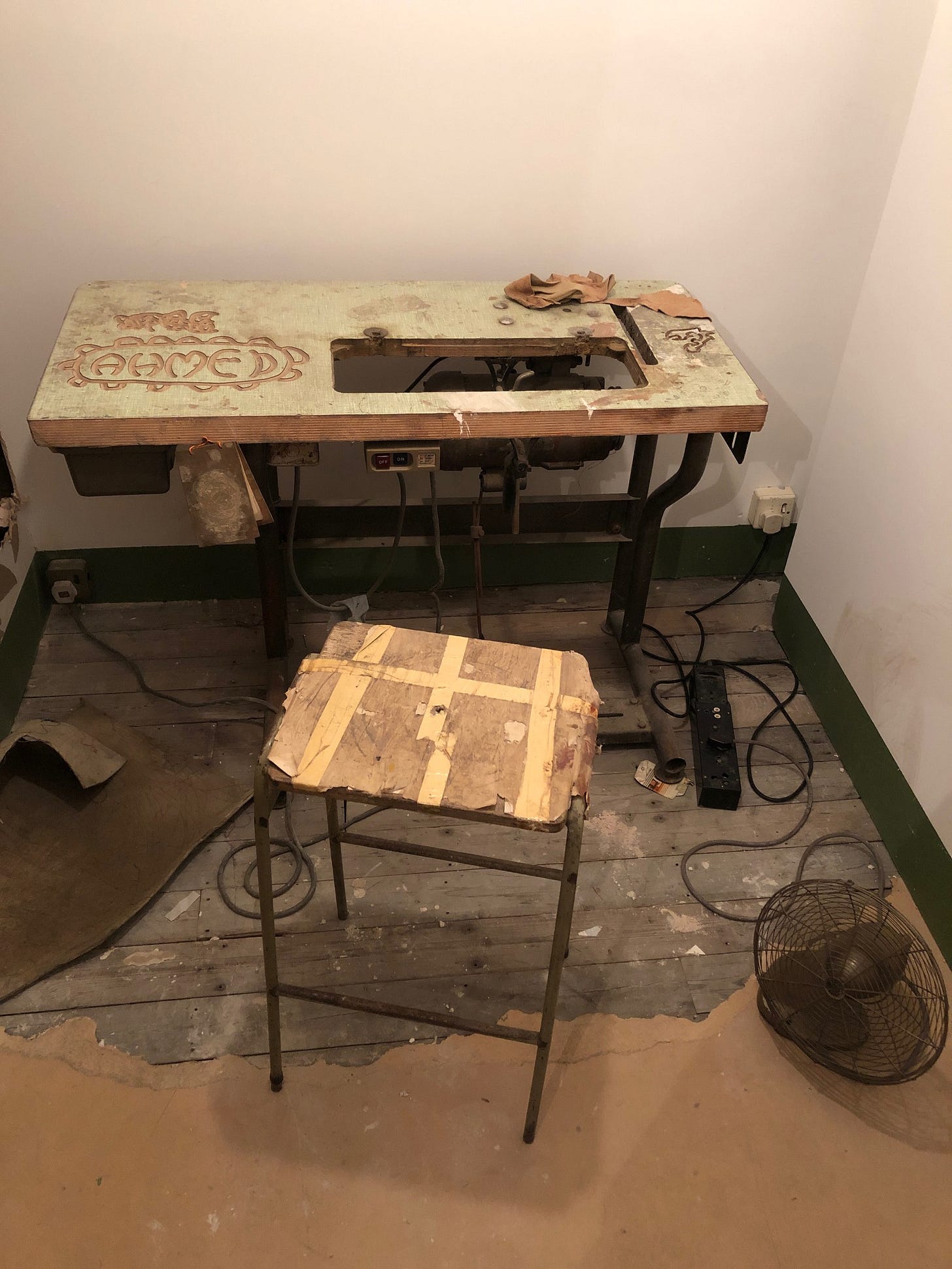
It looks and sounds fantastic!
Terrific post. Love it.